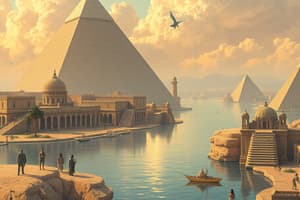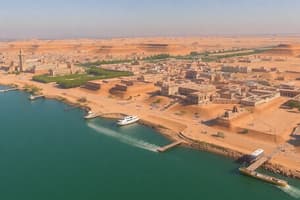Podcast
Questions and Answers
What does the Shadoof consist of?
What does the Shadoof consist of?
- An advanced water irrigation system that employs pumps
- A long balancing pole with a bucket and a weight (correct)
- A triangular structure made of bamboo for fishing
- A system of pipes used for transporting fresh water
Which of the following is NOT mentioned as an Egyptian surgical instrument?
Which of the following is NOT mentioned as an Egyptian surgical instrument?
- Lint
- Swabs
- Bandage
- Surgical scissors (correct)
How many symbols were used in the Egyptian decimal system?
How many symbols were used in the Egyptian decimal system?
- Twelve
- Five
- Seven (correct)
- Ten
What represented the number 1,000 in Egyptian hieroglyphic numbers?
What represented the number 1,000 in Egyptian hieroglyphic numbers?
Which procedure is mentioned as part of the Egyptian surgical practices?
Which procedure is mentioned as part of the Egyptian surgical practices?
Which instrument was NOT mentioned as being used by the Egyptians for preservation?
Which instrument was NOT mentioned as being used by the Egyptians for preservation?
What was the primary purpose of wigs among the Egyptians?
What was the primary purpose of wigs among the Egyptians?
Which of the following diseases is NOT associated with the ancient Egyptians?
Which of the following diseases is NOT associated with the ancient Egyptians?
Which component was used to create the black eye makeup known as kohl?
Which component was used to create the black eye makeup known as kohl?
Why did some Egyptians choose to wear wigs?
Why did some Egyptians choose to wear wigs?
Which ailment was specifically linked to parasitic flatworms in ancient Egypt?
Which ailment was specifically linked to parasitic flatworms in ancient Egypt?
What was a common pest problem faced by ancient Egyptians during hot summers?
What was a common pest problem faced by ancient Egyptians during hot summers?
What was one of the diseases that the Egyptians did suffer from?
What was one of the diseases that the Egyptians did suffer from?
What was the main purpose of the ancient Egyptians repairing canals during the Shemu season?
What was the main purpose of the ancient Egyptians repairing canals during the Shemu season?
Which farming tool was NOT used by the ancient Egyptians according to the content?
Which farming tool was NOT used by the ancient Egyptians according to the content?
During the Peret season, what agricultural activity was primarily carried out?
During the Peret season, what agricultural activity was primarily carried out?
What belief contributed to the ancient Egyptians' understanding of diseases?
What belief contributed to the ancient Egyptians' understanding of diseases?
Which animal was NOT mentioned as being kept by the ancient Egyptians?
Which animal was NOT mentioned as being kept by the ancient Egyptians?
What type of remedies did ancient Egyptians combine with prayer to address health issues?
What type of remedies did ancient Egyptians combine with prayer to address health issues?
What was the primary reason people wore eye makeup in ancient Egypt?
What was the primary reason people wore eye makeup in ancient Egypt?
Which ingredient was NOT mentioned as part of the ancient Egyptian toothpaste?
Which ingredient was NOT mentioned as part of the ancient Egyptian toothpaste?
What occurred in October that marked the beginning of the Peret season?
What occurred in October that marked the beginning of the Peret season?
Which of the following was a common misconception about the cause of diseases in ancient Egypt?
Which of the following was a common misconception about the cause of diseases in ancient Egypt?
In what step of the mummification process was the removal of internal organs performed?
In what step of the mummification process was the removal of internal organs performed?
What was the purpose of the announcement of death in ancient Egyptian culture?
What was the purpose of the announcement of death in ancient Egyptian culture?
Where were embalmers typically located during the mummification process?
Where were embalmers typically located during the mummification process?
Which of the following is a component of the ancient Egyptian toothpaste recipe mentioned?
Which of the following is a component of the ancient Egyptian toothpaste recipe mentioned?
What was the final step in the mummification process?
What was the final step in the mummification process?
What does the presence of malachite and galena in eye makeup suggest about ancient Egyptian practices?
What does the presence of malachite and galena in eye makeup suggest about ancient Egyptian practices?
What was the primary agricultural crop grown by ancient Egyptian farmers after the inundation period?
What was the primary agricultural crop grown by ancient Egyptian farmers after the inundation period?
Which of the following crops were NOT grown by ancient Egyptian farmers?
Which of the following crops were NOT grown by ancient Egyptian farmers?
Which group of people were primarily responsible for farming in ancient Egyptian society?
Which group of people were primarily responsible for farming in ancient Egyptian society?
How did the Nile River primarily benefit ancient Egyptian agriculture?
How did the Nile River primarily benefit ancient Egyptian agriculture?
What role did the Nile River play in the economy of ancient Egypt?
What role did the Nile River play in the economy of ancient Egypt?
What was the main currency used in ancient Egypt?
What was the main currency used in ancient Egypt?
Which of these sectors was NOT considered a major component of the Egyptian economy?
Which of these sectors was NOT considered a major component of the Egyptian economy?
What type of soil did the Nile River provide to the farmers of ancient Egypt?
What type of soil did the Nile River provide to the farmers of ancient Egypt?
What was the primary purpose of the final procession in the mummification process?
What was the primary purpose of the final procession in the mummification process?
Which organ was specifically protected by the son of Horus with a jackal head?
Which organ was specifically protected by the son of Horus with a jackal head?
What was used during the drying out process to remove moisture from the body?
What was used during the drying out process to remove moisture from the body?
Which step involves the preparation of the body by stuffing it with materials?
Which step involves the preparation of the body by stuffing it with materials?
During what process was the inside of the body treated with preserving fluids?
During what process was the inside of the body treated with preserving fluids?
What was the consequence of careless embalming during the preparation of the mummy?
What was the consequence of careless embalming during the preparation of the mummy?
What is the role of Hapy in the context of the sons of Horus?
What is the role of Hapy in the context of the sons of Horus?
How long was the body typically allowed to dry in the drying out process?
How long was the body typically allowed to dry in the drying out process?
Flashcards
Shadoof
Shadoof
A long balancing pole with a weight on one end and a bucket on the other, used to lift water and empty it onto higher ground.
Hieroglyphic Numbers
Hieroglyphic Numbers
A system of writing using hieroglyphs, where each symbol represents a number from 1 to 1,000,000.
Edwin Smith Papyrus
Edwin Smith Papyrus
An ancient Egyptian medical text describing 48 surgical cases, including a detailed list of instruments used during surgeries.
Mummification
Mummification
Signup and view all the flashcards
Ancient Egyptian Brain Study
Ancient Egyptian Brain Study
Signup and view all the flashcards
The Nile River
The Nile River
Signup and view all the flashcards
Ancient Egyptian farmers
Ancient Egyptian farmers
Signup and view all the flashcards
Pharaohs and farmers
Pharaohs and farmers
Signup and view all the flashcards
Egyptian economy
Egyptian economy
Signup and view all the flashcards
Grain in ancient Egypt
Grain in ancient Egypt
Signup and view all the flashcards
Ancient Egyptian crops
Ancient Egyptian crops
Signup and view all the flashcards
Gold in ancient Egypt
Gold in ancient Egypt
Signup and view all the flashcards
The Nile as a waterway
The Nile as a waterway
Signup and view all the flashcards
Peret
Peret
Signup and view all the flashcards
Shemu
Shemu
Signup and view all the flashcards
Winnowing Scoop
Winnowing Scoop
Signup and view all the flashcards
Flint-bladed Sickle
Flint-bladed Sickle
Signup and view all the flashcards
Plough
Plough
Signup and view all the flashcards
Hoe
Hoe
Signup and view all the flashcards
Rake
Rake
Signup and view all the flashcards
Ancient Egyptian Medicine
Ancient Egyptian Medicine
Signup and view all the flashcards
Scalpel
Scalpel
Signup and view all the flashcards
Scissors
Scissors
Signup and view all the flashcards
Forceps
Forceps
Signup and view all the flashcards
Spoon
Spoon
Signup and view all the flashcards
Lancet
Lancet
Signup and view all the flashcards
Probe
Probe
Signup and view all the flashcards
Pincers
Pincers
Signup and view all the flashcards
Brain Removal
Brain Removal
Signup and view all the flashcards
Green Eye Makeup
Green Eye Makeup
Signup and view all the flashcards
Ancient Egyptian Toothpaste
Ancient Egyptian Toothpaste
Signup and view all the flashcards
Announcement of Death
Announcement of Death
Signup and view all the flashcards
Embalming
Embalming
Signup and view all the flashcards
Removal of Internal Organs
Removal of Internal Organs
Signup and view all the flashcards
Powdered Ox Hooves
Powdered Ox Hooves
Signup and view all the flashcards
Wrapping of the Body
Wrapping of the Body
Signup and view all the flashcards
Hapy
Hapy
Signup and view all the flashcards
Duamutef
Duamutef
Signup and view all the flashcards
Internal Cleansing
Internal Cleansing
Signup and view all the flashcards
Body Stuffing
Body Stuffing
Signup and view all the flashcards
Drying the Body
Drying the Body
Signup and view all the flashcards
Wrapping the Mummified Body
Wrapping the Mummified Body
Signup and view all the flashcards
Final Procession
Final Procession
Signup and view all the flashcards
Opening of the Mouth Ceremony
Opening of the Mouth Ceremony
Signup and view all the flashcards
Study Notes
Ancient Egypt
- Located in northeastern Africa, centered around the Nile River Valley and Delta.
- Developed one of the earliest civilizations in the Middle East.
- Existed for approximately 3,000 years, with periods of foreign rule interspersed.
- Became a part of the Hellenistic world after Alexander the Great's conquest in 323 BC.
- Conquered by the Roman Empire in 30 BC.
Geographic Location
- Called "The Gift of the Nile" due to its dependence on the Nile River.
- The Nile River floods annually, creating fertile soil for farming.
- Majority of the population lives along the Nile River, where the arable land is concentrated.
- Vast desert areas cover the remainder of the land.
- Major cities include Cairo (largest) and Alexandria (second-largest).
Economy and Currency
- Economy was large, based on agriculture, natural resources, and tourism.
- Major sectors included agriculture, natural resources and tourism.
- Currency was the Egyptian Pound.
Ancient Egyptian Farming
- Grew crops like wheat, barley, vegetables, figs and melons.
- Flax was grown for linen production.
- Used irrigation techniques like the shaduf to bring water to fields.
- Cultivated the land during the growing season, harvest during the harvesting season.
Farming Technology
- Used tools like hoes, sickles, and plows.
- Developed irrigation systems and techniques to manage water. Examples include basin irrigation and the shaduf.
Ancient Egyptian Medicine
- Practiced medicine using natural remedies and surgical techniques.
- Included herbal remedies, prayers, and treatments for ailments.
- Performed surgeries like fixing broken bones and dislocations.
Egyptian Mathematics
- Used a decimal system with seven different symbols to represent numbers.
Mummification
-
A process of preserving the dead for the afterlife.
-
Involved removing internal organs, drying the body, and wrapping it with bandages.
-
Used canopic jars to store internal organs.
-
Involves preparing the body for the afterlife, utilizing rituals and procedures like cleaning, removing internal organs, and embalming the body.
-
Included prayers and rituals to ensure safe passage into the afterlife.
Studying That Suits You
Use AI to generate personalized quizzes and flashcards to suit your learning preferences.




